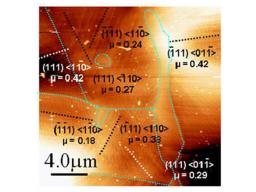

Fig.1: Example of contact mode AFM micrographs of the surface of a duplex stainless steel during a tensile test in air. In (a), the initial surface presents grains which are easily recognized. Ferrite grains (4, 7, 8, and 9) appear higher than the austenite ones. In (b), lines which are observed after a 0.6mm elongation of the specimen are steps. In grain#1, a series of parallel steps corresponds to emerging dislocations (one gliding system).In grain#2, there are two gliding systems.
In this work, damages induced by stress were investigated in situ by using the set up described above, which combines an AFM microscope working in contact mode, an electrochemical cell and a tensile micromachine. First, the changes in the surface morphology induced by plastic deformation of the specimen will be described and analysed. Then, we will report the first observation of nanometre damages generated by a stress in a corrosive environment.
As in the corrosion study presented above, two kinds of stainless steels were studied: austenitic steel (304L) and a duplex one containing an austenite and a ferrite phases (Uranus 50). The preparation of specimen presents many stages including mechanical and electrochemical polishing with a final mechano-chemical polishing. From AFM micrographs 5μm x 5μm in size, the best results characterizing the surface roughness are ~ RMS 0.5nm but the surface of some specimens present ripples.
It is well known that plastic deformation generates dislocations in crystals whose some of them emerge at the surface. The evolution of the surface morphologies of the two kinds of stainless steels has been
explored by in situ AFM during the plastic deformation. After the tensile test, Electron Back Scattered Diffraction (EBSD) measurements were performed on the area observed by AFM.
Fig. 1 presents examples of AFM micrographs documenting the evolution of the surface relief topography during the tensile test of the duplex steel. Before the tensile test, the different grains can be easily recognized from the orientation of ripples for the austenite grains. The ferrite grains, which are harder than the austenite ones appear clearer in the AFM images. This means that the preparation of the specimen surface yields prominent ferrite grains. After 0.6mm elongation of the sample, some austenite grains exhibit nearly equidistant lines, which correspond to the intersection of active slip planes with the grain surface (Fig. 1b). Indeed, these lines due to the emergence of dislocations are steps whose height can be accurately measured. After 0.8 mm elongation, both the density and theheight of the steps increase when compared to those observed in the 0.6mm elongation image. We also pointed out that a secondary slip system is activated in some austenite grains. In this image, no sign of plastic deformation was detected in the ferrite grains. Elsewhere on the surface, we observed the presence of steps in ferrite grains. These steps appear connected to the accumulation of dislocations in a neighbouring austenite grain.
In order to know the number of emerging dislocations attached to step, we need to identify the emerging dislocations (Bürgers vector). The identification requires the knowledge of the crystal orientation of each grain. Such data were obtained from EBSD measurements on the area observed by AFM.
As dislocations in austenite grains glide along {111} planes and parallel to <110> direction, we calculate the Schmid factor for all the possible gliding systems in the studied grains taking in account the direction of stress. The active dislocations in austenite grains will correspond to the higher value of the Schmid factor. [2] As the Bürgers vector of emerging dislocations is known, the number of dislocations attached to a step in the considered grain can be deduced. Applying this method of analysis on ferrite grains, we found that steps on these grains may correspond to two kinds of mechanism. In some cases, the steps correspond to the emergence of dislocations gliding along {110} plane as expected for BCC crystal. But, the steps for two grains of ferrite correspond to none these gliding planes indicating that these grains were sheared by dislocations accumulated in austenite grains at the ferrite/austenite interface [2].
A similar study combining AFM and EBSD measurement was performed on the austenitic stainless steel (304L). For this alloy, we notice that the number of emerging dislocations in a step increases faster for the secondary system than for the first one when the strain increases. Interestingly, the maximum number of dislocations in a step saturates at 110-120 units [1].
Recently, STM images of the steps induced by plastic deformation provide new insight on the active dislocations in 304L steel. As the lateral resolution of Scanning Tunnelling Microscopy (STM) is better than the AFM one, we explore these steps and found that the step side is formed by a single plane. This means that steps are due to a series of dislocations moving along a single gliding plane.
For corrosion under stress, we have studied the morphology changes of the surface of a 304L specimen under stress (580N) and at pitting potential (+300mV vs. Ag/AgCl). In AFM images, we observed that, after 15hours, a linear pit was interconnecting two parallel steps associated with emerging dislocations. Such a relief change was detected in the vicinity of a grain boundary. This first observation suggests that the grain boundary favours the formation of the pit, which advances along the gliding plane of emerging dislocations. [1]
REFERENCES :
[1] F. A. Martin, Ph.D. Thesis Paris VI (2005)
[2] S. Fréchard et al., Mater. Sci. Eng. A 418, 312–319 (2006)
•  Les archives de l'IRAMIS et du DRECAM / Archives of DRECAM and IRAMIS › Matériaux, surfaces et nanostructures
Les archives de l'IRAMIS et du DRECAM / Archives of DRECAM and IRAMIS › Matériaux, surfaces et nanostructures
• Laboratory of Physics and Chemistry of Surfaces and Interfaces • Service de Physique et Chimie des Surfaces et des Interfaces
• Laboratory of Oxide Surfaces and Interfaces • Laboratoire des Interfaces et Surfaces d'oxydes (LISO)











